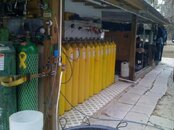Gentlemen,
Directly from the DOT, please read:
PHMSA - Interpretations by Regulation - Interpretation #11-0175
PHMSA - Interpretations - Interpretation #11-0238
PHMSA - Interpretations by Regulation - Interpretation #06-0064
PHMSA - Interpretations by Regulation - Interpretation #05-0060
Cylinders do need to be cleaned at 23.5% in the USA. International standards are 25% as is the US Navy's. Cylinders used in transportation in commerce are subject to regulations. 49CFR173.6 gives business owners a furtherance of trade exemption with a maximum weight of cylinders at 440lbs. Private individuals are limited to 490lbs. If you own a boat and are doing charters, that is commerce and you must comply. Again, read the above links but here are some excerpts:
Q1. Do the HMR apply to a cylinder that is transported to and from a dive shop by a private individual for personal use? Do the HMR apply to a cylinder that is filled by a dive shop and rented to a customer who then transports if off the premises?
Al. The HMR generally apply to the transportation of hazardous materials in commerce. Transportation of hazardous materials by a private individual in a private motor vehicle for personal use is riot commercial transportation. Note, however, that a cylinder that is marked to certify that it conforms to HMR requirements must he maintained in accordance with applicable specification requirements whether or not it is in transportation in commerce at any particular time.
Q2. Do the HMR apply to a cylinder that is shipped to a customer by UPS, FedEx, or other commercial carrier?
A2. Yes. A person, such as a dive shop, who offers a hazardous material for transportation in commerce or a person, such as a commercial carrier, who transports a hazardous material in commerce is subject to all applicable HMR requirements.
Q3. Do the HMR apply to a cylinder that is transported by a private individual in a private motor vehicle for personal use when transported on a public road or a Federal highway?
A3. See response Al above.
Q4. Do the HMR apply to a cylinder that is carried by a private individual on a commercial bus or boat licensed to carry passengers?
A4. Yes. Passengers and crew members traveling on a commercial bus or vessel are in commerce and are fully subject to the HMR.
Q5. Do the HMR apply to a cylinder owned by a private individual who takes it on a vessel licensed to carry passengers and has the cylinder filled while on the vessel?
Also from the above referenced OFFICIAL INTERPRETATIONS, which have the effect of law:
This responds to your letter regarding the requirements for compressed gas cylinders containing breathing enriched air (Nitrox) under the Hazardous Materials Regulations (HMR; 49 CFR Parts 171-180). Specifically, you state in your incoming letter that Department of Transportation (DOT) Specification 3AL (Aluminum) and 3AA (Steel) cylinders are commonly used for containment of Nitrox and the air in these cylinders will have elevated levels of Oxygen ranging from 21% to 100% depending on the application. Your questions are paraphrased and answered as follows:
Q1: If a cylinder is to be used to transport Nitrox, at what Oxygen percentage must a cylinder used for Oxygen service be cleaned and must the cylinder cleaning conform to the cleanliness standards specified in 173.302?
A1: Gas mixtures with Oxygen concentrations greater than 23.5% by volume should be considered to cause or contribute to combustion of other material to a greater extent than air. These gas mixtures must be described as "Compressed gas, oxidizing, n.o.s." and must be classified and labeled with a Division 2.2 (nonflammable gas) primary hazard and a Division 5.1 (oxidizer) subsidiary hazard. If the Oxygen concentration is greater than 23.5%, the conditions specified in § 173.302(b) must be met. Each DOT Aluminum cylinder, including a 3AL cylinder, must be cleaned in accordance with the requirements of General Services Administration (GSA) Federal Specification RR¿C¿901D, paragraphs 3.3.1 and 3.3.2 (IBR, see §171.7 of this subchapter). Cleaning agents equivalent to those specified in Federal Specification RR¿C¿901D may be used provided they do not react with Oxygen. One cylinder selected at random from a group of 200 or fewer and cleaned at the same time must be tested for oil contamination in accordance with Federal Specification RR¿C¿901D, paragraph 4.3.2, and meet the specified standard of cleanliness. The HMR does not indicate specific cleaning standards for 3AA steel cylinders used for Oxygen service.
Q2. What is the maximum pressure to which a cylinder can be filled, when charging the cylinder with enriched air containing elevated levels of Oxygen? Additionally, is this pressure the same for both aluminum and steel cylinders?
A2: For aluminum cylinders used for Oxygen service, including 3AL cylinders, the pressure in each cylinder may not exceed 3000 psig at 21 °C (70 °F) as specified in § 173.302(b). The HMR does not indicate a specific operating pressure for steel cylinders, including 3AA cylinders, used for Oxygen service, thus, the cylinder must not exceed the marked service pressure.
The DOT is adamant about cleaning at 23.5%. I attended DOT Multi-Modal training in Atlanta last June and they were quite clear. I was the only individual there from the dive industry, sadly as the training was free. I also attended the inaugural CGA Cylinder Requalification Seminar in Raleigh and the same message was hammered upon. My suggestion is to avail yourselves of the training and to ask questions of the DOT for clarification. You may be surprised at what you hear. There have been many misinterpretations by many well meaning people and this misinformation has been taken as fact by a host of people. Please check for yourselves.




